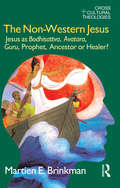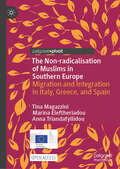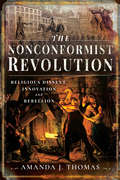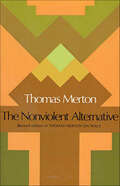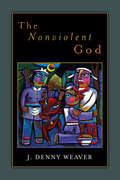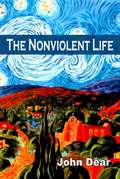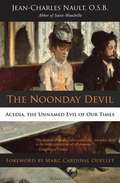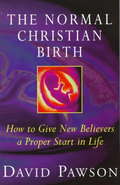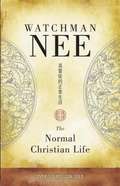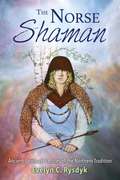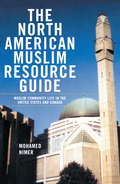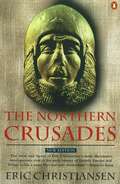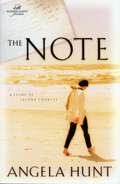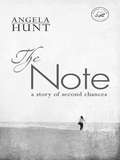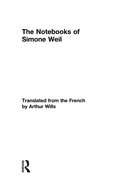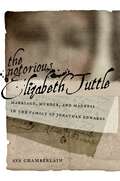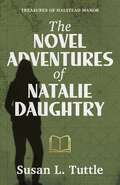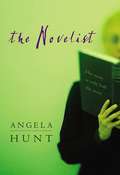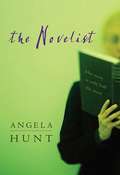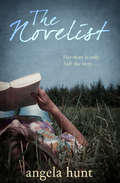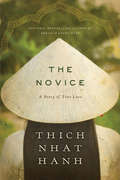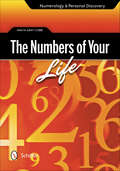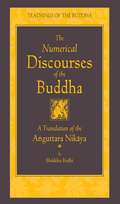- Table View
- List View
The Non-Jewish Jew: And Other Essays
by Isaac Deutscher Tamara DeutscherEssays on Judaism in the modern world, from philosophy and history to art and politicsIn these essays Deutscher speaks of the emotional heritage of the European Jew with a calm clear-sightedness. As a historian he writes without religious belief, but with a generous breadth of understanding; as a philosopher he writes of some of the great Jews of Europe: Spinoza, Heine, Marx, Trotsky, Luxemburg, and Freud. He explores the Jewish imagination through the painter Chagall. He writes of the Jews under Stalin and of the “remnants of a race“ after Hitler, as well as of the Zionist ideal, of the establishment of the state of Israel, of the Six-Day War, and of the perils ahead.
The Non-Western Jesus: Jesus as Bodhisattva, Avatara, Guru, Prophet, Ancestor or Healer? (Cross Cultural Theologies Ser.)
by M. E. Brinkman Henry Jansen Lucy JansenThe centre of gravity of contemporary Christianity has shifted to the southern hemisphere where, with the exception of Latin America, almost all Christians are minorities in their home countries. Christians in Asia live amongst Muslim, Hindu, Buddhist, Shamanist or Taoist majorities and this context shapes the local Christian theology. The same is true in Africa where traditional religions and beliefs influence African Christians. Central to this change in both Africa and Asia is the creation of a new Jesus, one who accretes local beliefs and concerns and who, in that process, is transformed. 'The Non-Western Jesus' reveals how a new theology - with its own images and concepts - is coming into being. A wide range of embodiments of Jesus is examined: Jesus as 'Avatara' and 'Guru' in the Indian context; as 'Bodhisattva' in the Buddhist context; and Jesus within Asian, Chinese, Japanese, Korean, African and Indonesian religious contexts.
The Non-radicalisation of Muslims in Southern Europe: Migration and Integration in Italy, Greece, and Spain (Rethinking Political Violence)
by Anna Triandafyllidou Tina Magazzini Marina EleftheriadouThis open access book explains why southern European countries with significant Muslim communities have experienced few religiously inspired violent attacks – or have avoided the kind of securitised response to such attacks seen in many other Western states. The authors provide a unique contribution to the literature on violent extremism – which has traditionally focused on countries such as France, the US and the UK – by studying the causes of relatively low rates of radicalisation in Greece, Italy and Spain. The book explores many of the dynamics between (non) radicalisation and issues such as socioeconomic inequality, experiences of conflict, and systemic racism and other forms of discrimination. It establishes a new analytical framework for the development of, and resilience against, violent radicalisation in the region and beyond.
The Nonconformist Revolution: Religious Dissent, Innovation and Rebellion
by Amanda J ThomasA historian examines the evolution of dissenting thought and how it shaped the transformation of England from a rural to an urban, industrialized society.The foundations for the Industrial Revolution were in place from the late Middle Ages, when the early development of manufacturing processes and changes in the structure of rural communities began to provide opportunities for economic and social advancement. Successive waves of Huguenot migrants and the influence of Northern European religious ideology also played an important role in this process. The Civil Wars would provide a catalyst for the dissemination of new ideas and help shape the emergence of a new English Protestantism and divergent dissident sects. The persecution that followed strengthened the Nonconformist cause, and for the early Quakers it intensified their unity and resilience—qualities that would prove to be invaluable for business. The book proceeds to explore how in the years following the Restoration, Nonconformist ideas fueled enlightened thought, creating an environment for enterprise but also a desire for more radical change, how reformers seized on the plight of a working poor alienated by innovation and frustrated by false promises—and how the vision which was at first the spark for innovation would ignite revolution.
The Nonviolent Alternative
by Thomas MertonFrom the Trappist monk and author of The Seven Storey Mountain, reflections on the way to moral and social change in a violent world.The writings in this work were precipitated by a variety of events during the last decades of Thomas Merton’s life—the civil rights and peace movements of the 1960s among them. His timeless moral integrity and tireless concern for nonviolent solutions to war are eloquently expressed. A revised edition of the previously published Thomas Merton on Peace, The Nonviolent Alternative addresses such topics as Christianity and defense in the nuclear age; the Danish nonviolent resistance to Hitler; civil disobedience; wartime atrocities; passivity and abuse of authority; and more. It is a meaningful and thought-provoking read for anyone concerned with maintaining faith and making ethical, effective decisions in a world filled with conflict and injustice.Praise for the first edition“These articles represent a radically spiritual breakthrough beyond the ‘self-enclosed . . . beautiful, narcissistic tautology of war’ to a certainty of a peace without limit and time.” —Kirkus Reviews
The Nonviolent God
by J. Denny WeaverThis bold new statement on the nonviolence of God challenges long-standing assumptions of divine violence in theology, the violent God pictured in the Old Testament, and the supposed violence of God in Revelation. In The Nonviolent God J. Denny Weaver argues that since God is revealed in Jesus, the nonviolence of Jesus most truly reflects the character of God.According to Weaver, the way Christians live -- Christian ethics -- is an ongoing expression of theology. Consequently, he suggests positive images of the reign of God made visible in the narrative of Jesus -- nonviolent practice, forgiveness and restorative justice, issues of racism and sexism, and more -- in order that Christians might live more peacefully.
The Nonviolent Life
by John DearNonviolence Toward Ourselves, Nonviolence Toward All Others, Joining the Global Grassroots Movement of Nonviolence.
The Noonday Devil: Acedia, The Unnamed Evil Of Our Times
by Michael J. Miller Dom Jean-Charles Nault Marc OuelletThe noonday devil is the demon of acedia, the vice also known as sloth. The word “sloth”, however, can be misleading, for acedia is not laziness; in fact it can manifest as busyness or activism. Rather, acedia is a gloomy combination of weariness, sadness, and a lack of purposefulness. It robs a person of his capacity for joy and leaves him feeling empty, or void of meaning <P><P> Abbot Nault says that acedia is the most oppressive of demons. Although its name harkens back to antiquity and the Middle Ages, and seems to have been largely forgotten, acedia is experienced by countless modern people who describe their condition as depression, melancholy, burn-out, or even mid-life crisis. <P><P> He begins his study of acedia by tracing the wisdom of the Church on the subject from the Desert Fathers to Saint Thomas Aquinas. He shows how acedia afflicts persons in all states of life— priests, religious, and married or single laymen. He details not only the symptoms and effects of acedia, but also remedies for it.
The Normal Christian Birth: How to Give New Believers a Proper Start in Life
by David PawsonBasing his study on the New Testament, David Pawson advocates a synthesis of the 'liberal' emphasis on repentance, the 'evangelical' on faith, the 'sacramental' on baptism and the 'pentecostal' on the Spirit. He then relates these 'spiritual dooes' to the concepts of conversion and regeneration.The Normal Christian Birth looks at crucial and controversial texts, challenging traditional interpretations. The final section on evangelistic counselling questions the adequacy of the typical 'sinner's prayer' approach. Drawing from scripture and experience, David Pawson gives many practical tips on helping potential discipes to repent, believe, be baptised and receive the Spirit.
The Normal Christian Life
by Watchman NeeThis classic work unfolds the path of faith and presents the eternal purpose of God in simple terms.
The Norse Shaman: Ancient Spiritual Practices of the Northern Tradition
by Evelyn C. RysdykAn experiential guide to the wisdom preserved in Europe’s far north• Includes shamanic journeys to connect with deities and your ancestral shamans• Provides step-by-step instructions to prepare for and conduct a seiðr ceremony• Draws on archaeological evidence and surviving written records from Iceland• Reveals the long tradition of female shamans in northern European shamanismShamanism is humanity’s oldest spiritual tradition. In much of the Western world, the indigenous pre-Christian spiritual practices have been lost. Yet at the northern fringes of Europe, Christianity did not displace the original shamanic practices until the end of the Viking age. Remnants of Norse shamanic spirituality have survived in myths, folk traditions, and written records from Iceland, providing many clues about the ancient European shaman’s world, especially when examined in conjunction with other shamanic cultures in northern Eurasia, such as the Sami and the tribes of Siberia.Reconstructing the shamanic practices of the hunter-gatherers of Scandinavia, Evelyn Rysdyk explores the evolution of Norse shamanism from its earliest female roots to the pre-Christian Viking Age. She explains how to enter Yggdrasil, the World Tree, to travel to other realms and provides shamanic journeys to connect with the ancestral shamans of your family tree, including the Norse goddess Freyja, the very first shaman. She offers exercises to connect with the ancient goddesses of fate, the Norns, and introduces the overnight wilderness quest of útiseta for reconnecting with the powers of nature. She explains the key concepts of Ørlög and Wyrd--the two most powerful forces that shape human lives--and provides exercises for letting go of harmful behavior patterns and transforming simple knowledge into profound wisdom by connecting with Óðinn.Thoroughly examining the shamanic rituals of seiðr, the oracular magic of the Nordic cultures, the author provides step-by-step instructions to prepare for and conduct a seiðr ceremony, including creating your own seiðr staff and hood, and explores the ancestral use of shamanic songs or varðlokur to accompany the ceremony. Woven throughout these exercises, Rysdyk provides archaeological evidence from Neolithic sites supporting the long tradition of venerating wise women, grandmothers, and mothers in ancient cultures and the important role of female shamans at the heart of northern European shamanism. Providing an accessible guide for anyone trying to fulfill their shamanic callings, these powerful rituals can provide personal healing and a clear path for finding our way into a harmonious relationship with the natural world.
The North American Muslim Resource Guide: Muslim Community Life in the United States and Canada
by Mohamed NimerThis useful resource provides basic information about Islamic life in the United States. Coverage includes population statistics and analysis, as well as immigration information that tracks the settlement of Islamic people in the America. The guide contains contact information for mosques, community organizations, schools, women's groups, media, and student groups. Recent Islamic-American events over the past five years are also reviewed.To see the Introduction, the table of contents, a generous selection of sample pages, and more, visit the The North American Muslim Resource Guide website.
The Northern Crusades
by Eric ChristiansenThe 'Northern Crusades', inspired by the Pope's call for a Holy War, are less celebrated than those in the Middle East, but they were also more successful: vast new territories became and remain Christian, such as Finland, Estonia and Prussia. Newly revised in the light of the recent developments in Baltic and Northern medieval research, this authoritative overview provides a balanced and compelling account of a tumultuous era.
The Note
by Angela Elwell HuntEn route from New York's LaGuardia Airport to Tampa International, Flight 848 bursts into flames and crashes into Tampa Bay. All 261 passengers and crew are killed. For one week, newspaper columnist Peyton MacGruder and her fellow reporters cover one of the nation's worst air disasters in years with overwhelming and numbed emotions. Then a woman Peyton's never met gives her a plastic bag that has washed up behind her house. The bag contains a note, almost certainly from the doomed flight, with a simple yet wrenching message: T- I love you. All is forgiven. -Dad. Combing through the passenger list to find the victims whose children's names begin with T, Peyton is determined to deliver the note to its proper owner. A quest which will prove as important to Peyton's own life as to the mysterious T.
The Note
by Angela HuntWhen the unthinkable happens . . . En route from New York's LaGuardia Airport to Tampa International, Flight 848 bursts into flames and crashes into Tampa Bay. All 261 passengers and crew are killed. For one week, newspaper columnist Peyton MacGruder and her fellow reporters cover one of the nation's worst air disasters in years with overwhelming and numbed emotions.Then a woman Peyton's never met gives her a plastic bag that has washed up behind her house. The bag contains a note, almost certainly from the doomed flight, with a simple yet wrenching message: T- I love you. All is forgiven. -DadCombing through the passenger list to find the victims whose children's names begin with T, Peyton is determined to deliver the note to its proper owner. A quest which will prove as important to Peyton's own life as to the mysterious T.
The Notebooks of Simone Weil
by Simone WeilSimone Weil (1909-1943) was a defining figure of the twentieth century; a philosopher, Christian, resistance fighter, anarchist, feminist, Labour activist and teacher. She was described by T. S. Eliot as 'a woman of genius, of a kind of genius akin to that of the saints', and by Albert Camus as 'the only great spirit of our time'. Originally published posthumously in two volumes, these newly reissued notebooks, are among the very few unedited personal writings of Weil's that still survive today. Containing her thoughts on art, love, science, God and the meaning of life, they give context and meaning to Weil's famous works, revealing an unique philosophy in development and offering a rare private glimpse of her singular personality.
The Notion of Ditthi in Theravada Buddhism: The Point of View (Routledge Critical Studies in Buddhism)
by Paul FullerThe notion of 'view' or 'opinion' (ditthi) as an obstacle to 'seeing things as they are' is a central concept in Buddhist thought. This book considers the two ways in which the notion of views are usually understood. Are we to understand right-view as a correction of wrong-views (the opposition understanding) or is the aim of the Buddhist path the overcoming of all views, even right-view (the no-views understanding)? The author argues that neither approach is correct. Instead he suggests that the early texts do not understand right-view as a correction of wrong-view, but as a detached order of seeing, completely different from the attitude of holding to any view, wrong or right.
The Notorious Elizabeth Tuttle: Marriage, Murder, and Madness in the Family of Jonathan Edwards (North American Religions #6)
by Ava ChamberlainWho was Elizabeth Tuttle?In most histories, she is a footnote, a blip. At best, she is a minor villain in the story of Jonathan Edwards, perhaps the greatest American theologian of the colonial era. Many historians consider Jonathan Edwards a theological genius, wildly ahead of his time, a Puritan hero. Elizabeth Tuttle was Edwards’s “crazy grandmother,” the one whose madness and adultery drove his despairing grandfather to divorce.In this compelling and meticulously researched work of micro-history, Ava Chamberlain unearths a fuller history of Elizabeth Tuttle. It is a violent and tragic story in which anxious patriarchs struggle to govern their households, unruly women disobey their husbands, mental illness tears families apart, and loved ones die sudden deaths. Through the lens of Elizabeth Tuttle, Chamberlain re-examines the common narrative of Jonathan Edwards’s ancestry, giving his long-ignored paternal grandmother a voice. Tracing this story into the 19th century, she creates a new way of looking at both ordinary families of colonial New England and how Jonathan Edwards’s family has been remembered by his descendants,contemporary historians, and, significantly, eugenicists. For as Chamberlain uncovers, it was during the eugenics movement, which employed the Edwards family as an ideal, that the crazy grandmother story took shape.The Notorious Elizabeth Tuttle not only brings to light the tragic story of an ordinary woman living in early New England, it also explores the deeper tension between the ideal of Puritan family life and its messy reality, complicating the way America has thought about its Puritan past.
The Novel Adventures of Natalie Daughtry (Treasures of Halstead Manor #2)
by Susan L. TuttleIn pursuit of a rare book, will Natalie and Mason find each other again? With her twenty-plus-year marriage on the brink of collapse, bookish Natalie Daughtry immerses herself in her new bookstore job. When the mysterious Caspar gathers Natalie and her friends Everleigh and Brooke for the second time, she's ready for an adventure to disperse the turmoil clouding her marriage. Caspar enlists their help in searching for a rumored copy of Lewis Carroll's handwritten and illustrated manuscript of Alice's Adventures Under Ground. Natalie is immediately enticed--this is the perfect distraction. But then Mason joins the team, and suddenly Natalie and her husband are side-by-side on the search for this elusive treasure. Being forced to work together has them tumbling deep into their past, seeking answers to old misunderstandings. When they emerge from the rabbit hole, things aren't the same. Will they rediscover the love that once held the pages of their life together?
The Novelist
by Angela Elwell Huntordan Kerrigan's spy novels have sold millions---but her mentally ill son, Zack, seems beyond her power to help. As Zack's behavior grows increasingly dangerous and suicidal, Jordan's internal "inside the book" world overlaps with her painful everyday existence. A deeply moving exploration of fiction, faith, God's sovereignty, and man's free will.
The Novelist
by Angela HuntFrom the author who taught you to expect the unexpected...an intriguing tale about families, fiction, and what to do when life veers wildly off script. It begins...when a smug college student challenges a best-selling novelist to write something "more personal." It begins...when a mother finds her troubled son slumped unconscious outside her house. It begins...when fiction and reality blur, and the novelist finds herself caught somewhere in the middle of it all. Where does it end? That all depends on who is telling the story...
The Novelist: Her Story Is Only Half The Story (Hunt Ser.)
by Angela HuntA moving tale about a mother finding her voice and speaking her truth as she tries to save her son, from a Christy Award–winning author. When novelist Jordan Casey is challenged by a writing student to write something from her heart instead of her usual bestselling claptrap, she decides to accept the challenge. Departing from her usual adventure novels, Jordan begins to work on a story that allows her to explore and express her faith for the first time—something she had always been reluctant to pursue. As she writes, she hopes to be able to teach her students—but she is also motivated by something else: a desire to reconnect with her son, Zach. But stories have lives of their own and soon Jordan finds her real life intermingling with fiction, especially as Zach’s suicidal desires come to life. Will Jordan discover how to save her son, while also saving herself? This is a powerful novel that Publishers Weekly states is “guaranteed to wring tears from even the hardest-hearted reader.”
The Novice
by Thich Nhat HanhBestselling author and Zen Master Thich Nhat Hanh transforms an ancient folktale into a timeless parable of a young woman who dares to risk her life for her faith. Born to an aristocratic family in rural Vietnam, Kinh Tam's uncommon beauty and intelligence were obvious to all she encountered. From an early age she was drawn to the teachings of Buddha and the rewards of a monastic life, but to please her family she agreed to walk the traditional path of marriage. Throughout her marriage, Kinh Tam's mind was devoted to her husband but her heart never waivered from her true calling. She wanted to be a monk. And yet Buddhism was still new to Vietnam and temples accepted only men for ordination. Making a decision that would forever change her life, Kinh Tam left town, disguised herself as a man, and joined a monastery as a novice. Despite the many challenges of living as a man, Kinh Tam thrived and became a beloved member of the community. Years of profound joy and peace passed until a local woman accuses the novice of fathering her unborn child. Kinh Tam is torn between two impossible choices: keep her secret and endure brutal punishment or reveal the truth that would prove her innocence but put an end to her spiritual path.Facing the unbearable with the boundless heart of Buddha, her choice forever changes her life, her country, and her faith. In spare, elegant prose, Thich Nhat Hanh reminds us that we, too, face our own injustices and suffering, and by connecting with love, we can, like Kinh Tam, discover a mind and heart that are peaceful, happy, and free.
The Numbers of Your Life: Numerology & Personal Discovery
by Maiya Gray-CobbUnderstand your numbers and effectively shape your futureDiscover your karma and past life, then guide your own fate with your personal lifecycleMake your own character chart plus charts for family and friends
The Numerical Discourses of the Buddha
by Bhikkhu BodhiLike the River Ganges flowing down from the Himalayas, the entire Buddhist tradition flows down to us from the teachings and deeds of the historical Buddha, who lived and taught in India during the fifth century B.C.E. To ensure that his legacy would survive the ravages of time, his direct disciples compiled records of the Buddha's teachings soon after his passing. In the Theravada Buddhist tradition, which prevails in Sri Lanka and Southeast Asia, these records are regarded as the definitive "word of the Buddha." Preserved in Pali, an ancient Indian language closely related to the language that the Buddha spoke, this full compilation of texts is known as the Pali Canon. At the heart of the Buddha's teaching were the suttas (Sanskrit sutras), his discourses and dialogues. If we want to find out what the Buddha himself actually said, these are the most ancient sources available to us. The suttas were compiled into collections called "Nikayas," of which there are four, each organized according to a different principle. The Digha Nikaya consists of longer discourses; the Majjhima Nikaya of middle-length discourses; the Samyutta Nikaya of thematically connected discourses; and the Anguttara Nikaya of numerically patterned discourses. The present volume, which continues Wisdom's famous Teachings of the Buddha series, contains a full translation of the Anguttara Nikaya. The Anguttara arranges the Buddha's discourses in accordance with a numerical scheme intended to promote retention and easy comprehension. In an age when writing was still in its infancy, this proved to be the most effective way to ensure that the disciples could grasp and replicate the structure of a teaching.

